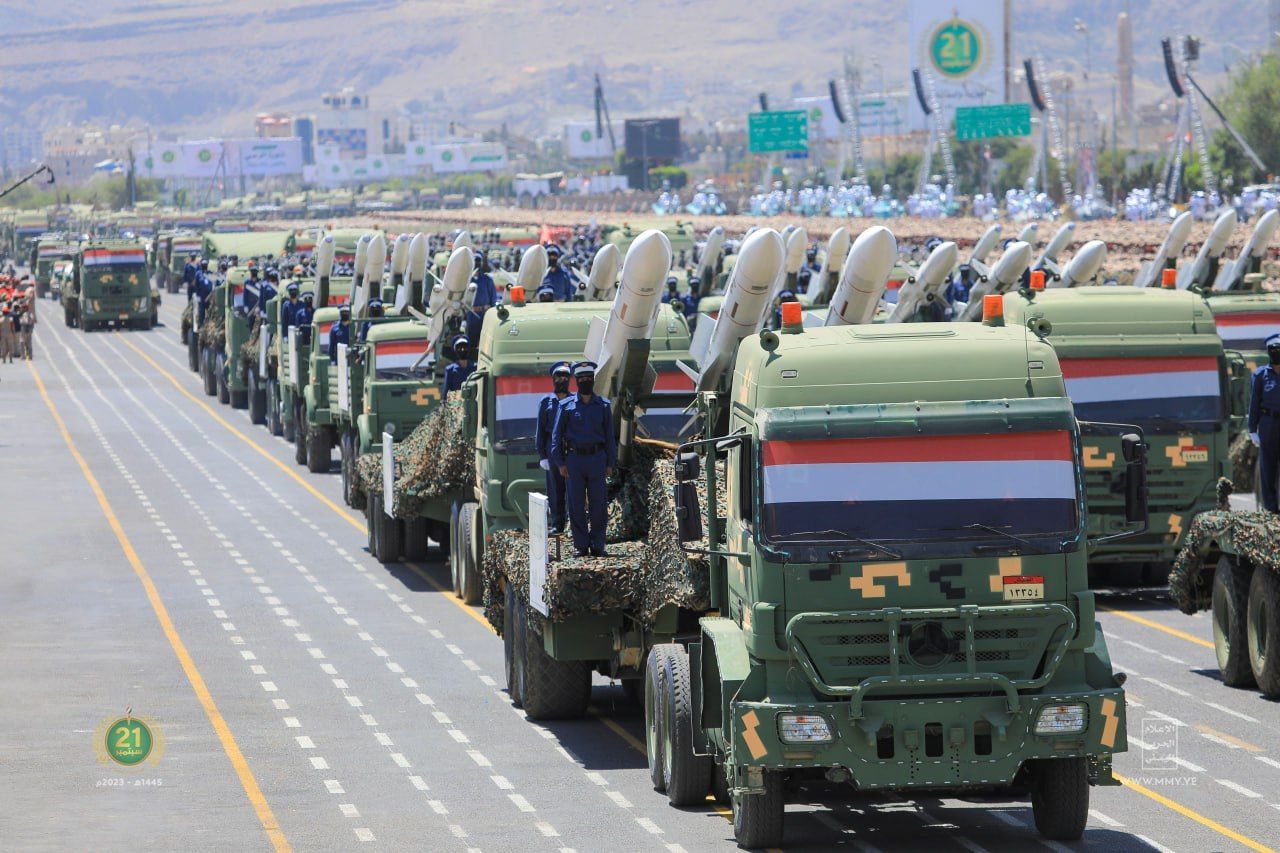
Houthi military parade (Houthi media)
Last updated on: 27-01-2024 at 12 AM Aden Time

“The Houthis lack advanced intelligence, surveillance, and reconnaissance (ISR) tools, such as maritime patrol aircraft and satellites, which are usually associated with providing targeting information for long-range anti-ship systems.”
Abdullah Al-Shadli (South24)
The Iran-backed Houthi militia have vowed a military response to the American-British strikes of January 12, 2024, and subsequent ones that targeted their locations in Sanaa and other governorates. What are the Houthi’s military capabilities and what can they do against the United States?
Disclosed capabilities
The Houthi official website provides details and photos of their most prominent military and naval capabilities. This includes anti-ship ballistic missiles, cruise missiles [portable missiles], gunboats and naval mines. The website names the list of missiles including ’Mayon‘, ’Falaq‘, ’Falaq1‘, ’Asef‘. ’Almandab1‘, ’Almandab2‘, ’Moheet', ‘Sayyad’, ‘Tankil’ and the Russian-manufactured ‘Rubez’.
The Houthis describe the ‘Mayon’ as ‘a medium range surface-to-sea’ ballistic missile which is powered by solid fuel. It is capable of hitting stationary and moving maritime targets. ‘Sayyad’ is a “winged surface-to-sea” cruise missile with a range of 800 km. It is powered by solid and liquid fuel. Its length is 6.80 m, and its warhead weighs 200 kg.
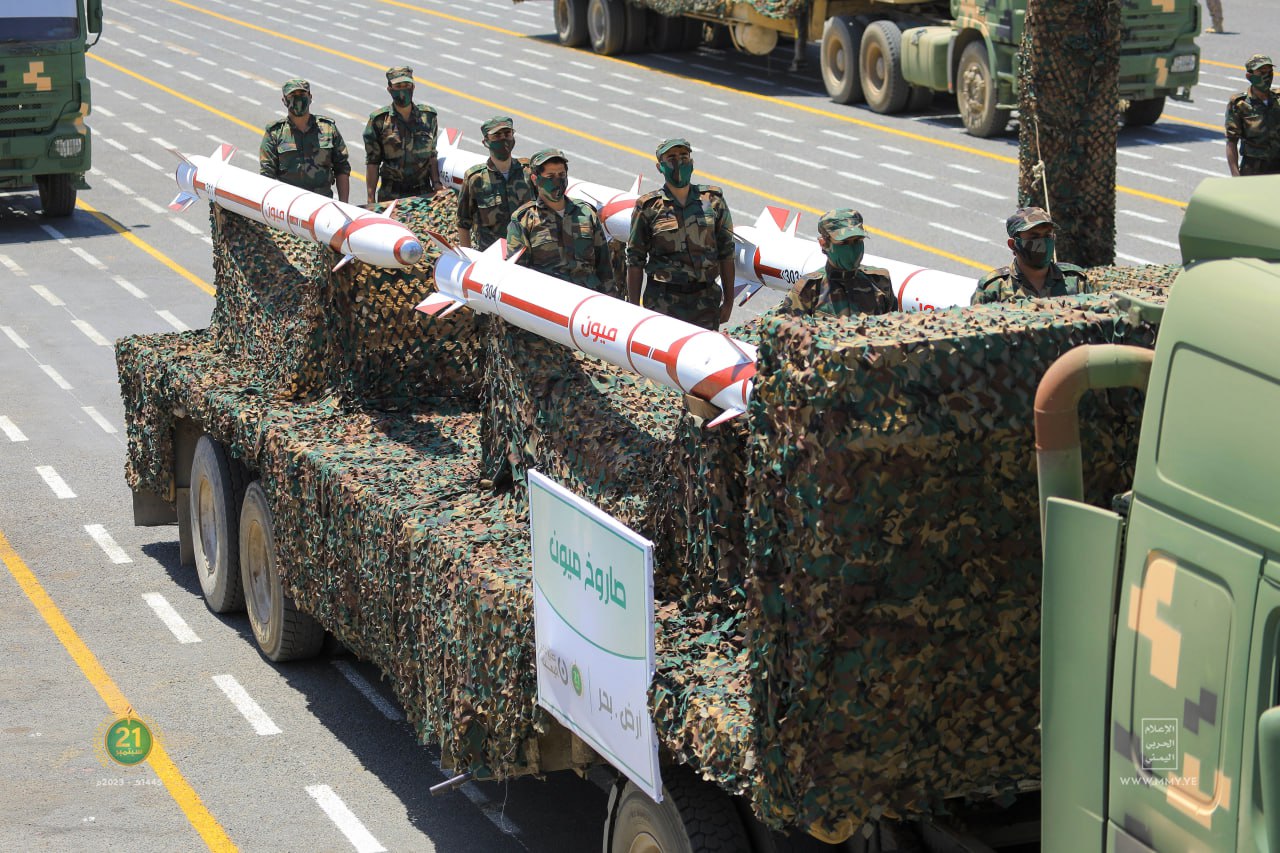
The ’Mayon‘ missile (the Houthi official website)
According to the Houthi website, ‘Tankil’ is “a surface-to-surface and surface-to-sea medium-range ballistic missile system, which is powered by solid fuel. It has two versions: surface-to-surface and surface-to-sea”. Quds Z-0 is “a cruise land-to-sea anti-ship long-range missile”. In addition, the surface-to-sea ballistic missile ’Faleq’ is “capable of capturing targets optically and thermally. Its range is 140 km and the weight of its explosive head is 105 kg. It is powered by solid fuel”.
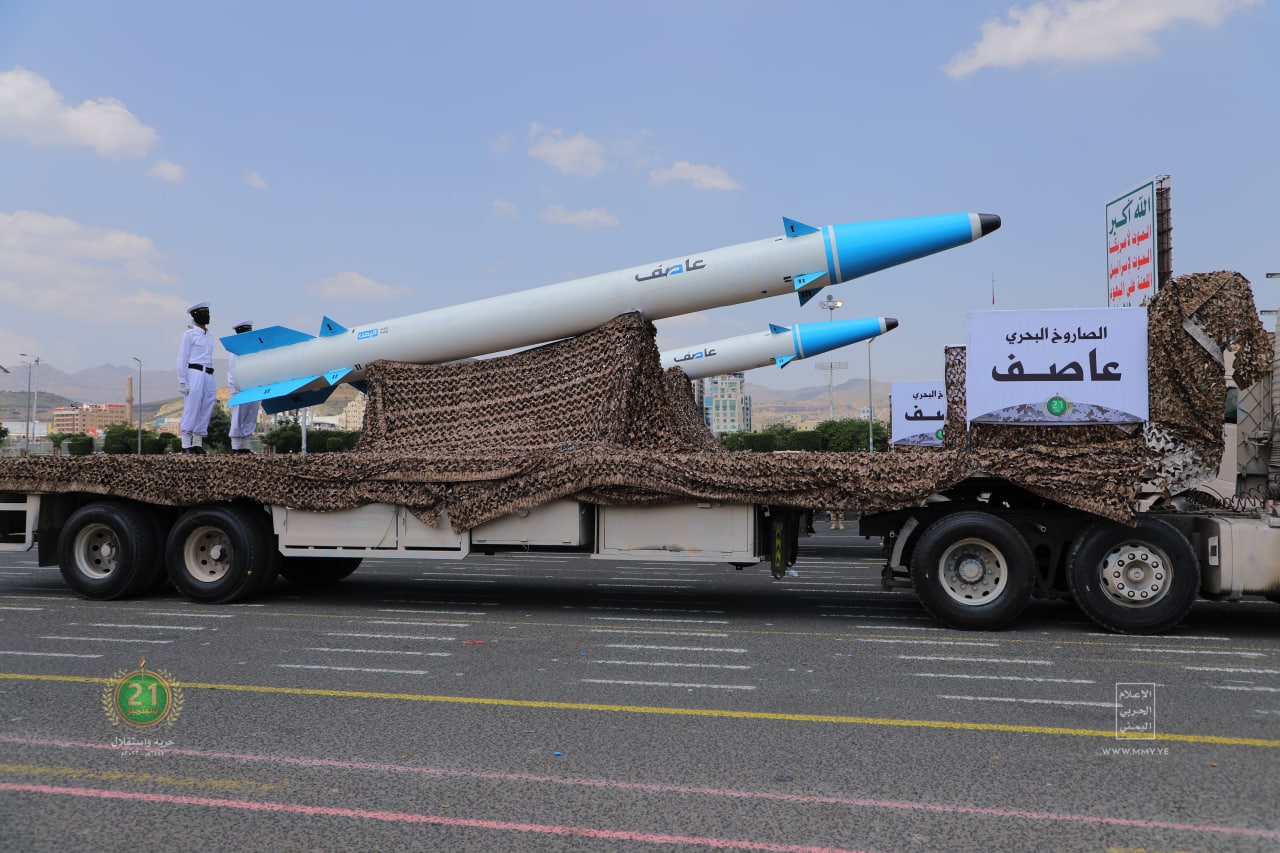
‘Asef’ Missile (The official Houthi website)
The Houthis describe ’Mandab1‘ as “a locally-developed missile based on the Chinese-manufactured missile C801. Its length is 5.81 m and it has a diameter of 0.36 m. It is powered by solid fuel”. ‘Mandab 2’ is “a winged maritime cruise missile. Its length is 7 m and it has a diameter of 0.36 m. It is powered by liquid fuel and has a range of 300 km”.
According to the International Institute for Strategic Studies, “Asef 2 has a 450 km range and appears to be a rebranded ASBM (anti-ship ballistic missile) version of Iran’s Fateh 313 missile, while the Tankil represents a previously unseen anti-ship version of the Islamic Revolutionary Guard Corps (IRGC)-developed 500 km range Zohayr. The two designs constitute the heaviest Houthi anti-ship missiles, both with warheads of more than 300 kilograms, and are of Iranian origin”.
The Houthi gunboats include ‘Mallah’, ‘Tufan1’, ‘Tufan2’, ‘Tufan3’, ‘Nazir’, ‘Asef1’, ‘Asef2’ and ‘Asef3’. The naval mines include ‘Thaqeb’, ‘Karar1’, ‘Karar2’, ‘Karar3’, ‘Owais’, ‘Masjor1’, ‘Masjor2’, ‘Asef’, ‘Mujahid1’, ‘Mujahid2’ and ‘Al-Naziaat’.
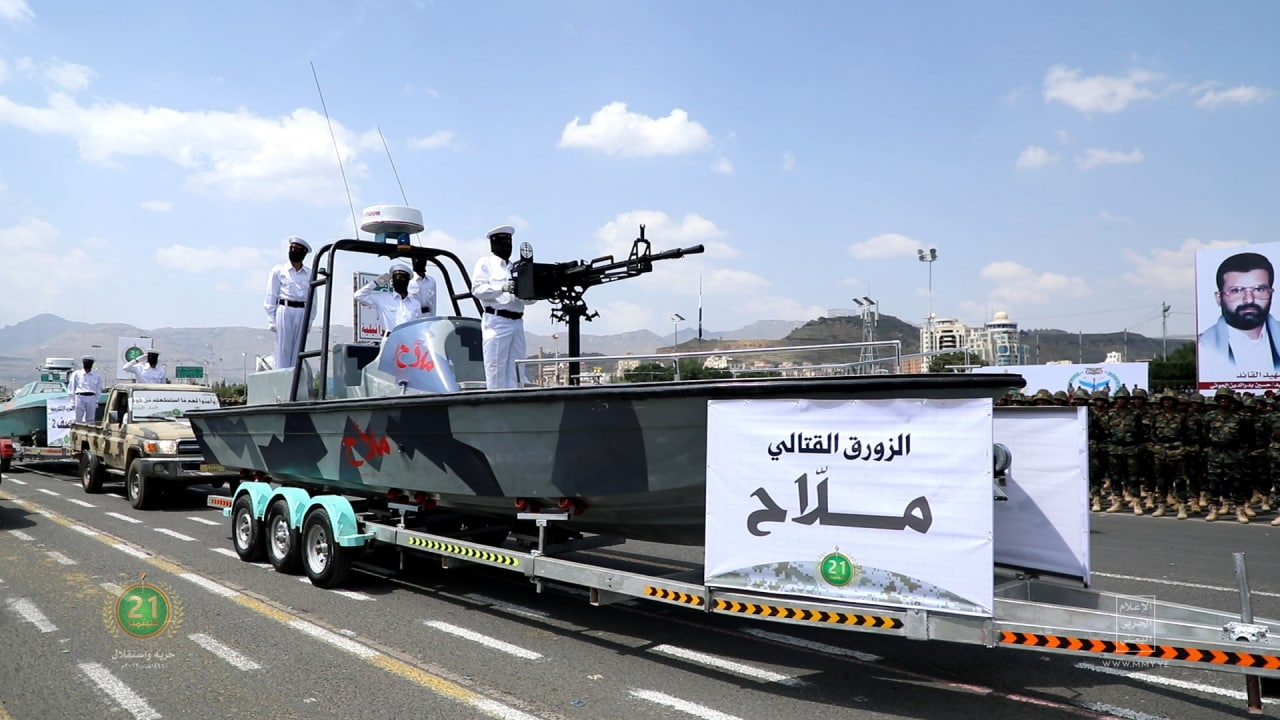
‘Mallah’ gunboat (Houthi official website)
The Houthis describe ‘Tufan3’ as being “a locally-manufactured unmanned attack boat. It carries a warhead weighing 500 kg and has a speed of 52 nautical miles per hour”. According to the Houthis the homemade ‘Nazir’ is “a combat boat that has the ability to maneuver. It carries medium weapons and air defense, such as a 23 mm cannon. Its crew includes six persons”.
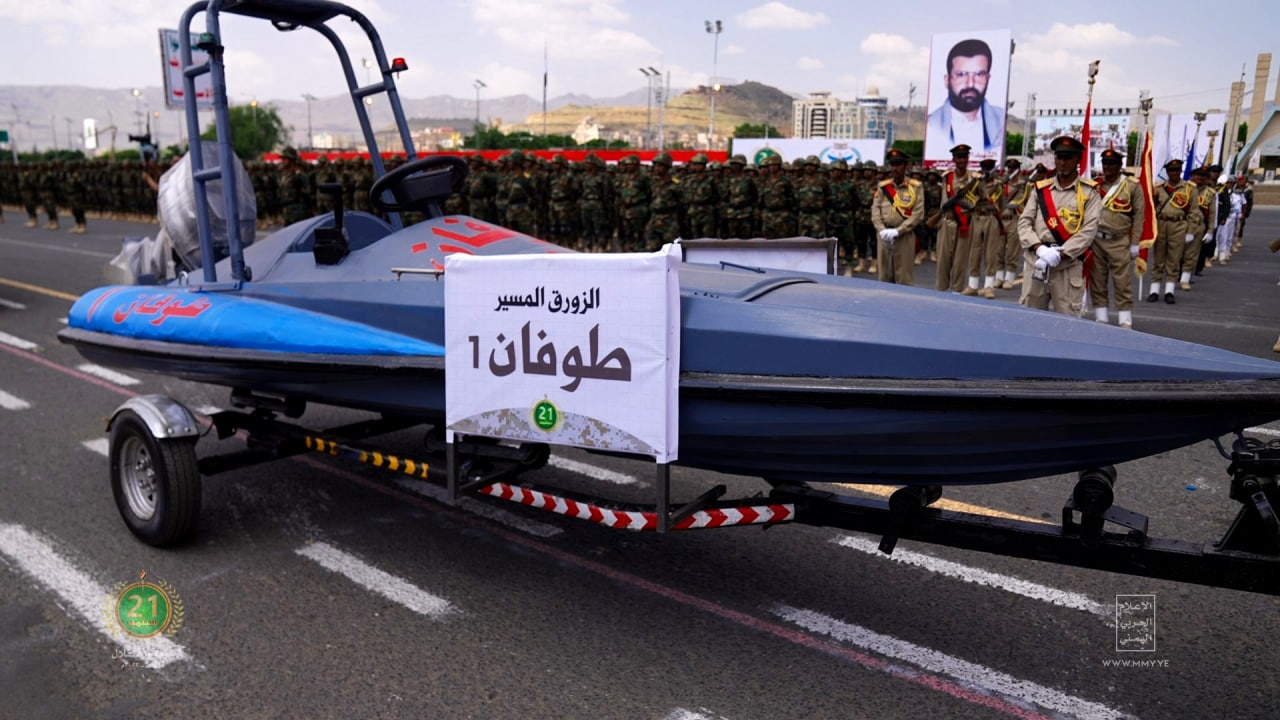
Manned boat ‘Tufan1’ (The Houthi official website)
The militia said that ’Asef3‘ is considered “one of the fastest boats with superior maneuverability. It can carry medium weapons and air defense such as 23-caliber anti-aircraft guns. The boat can carry six people and their equipment”.
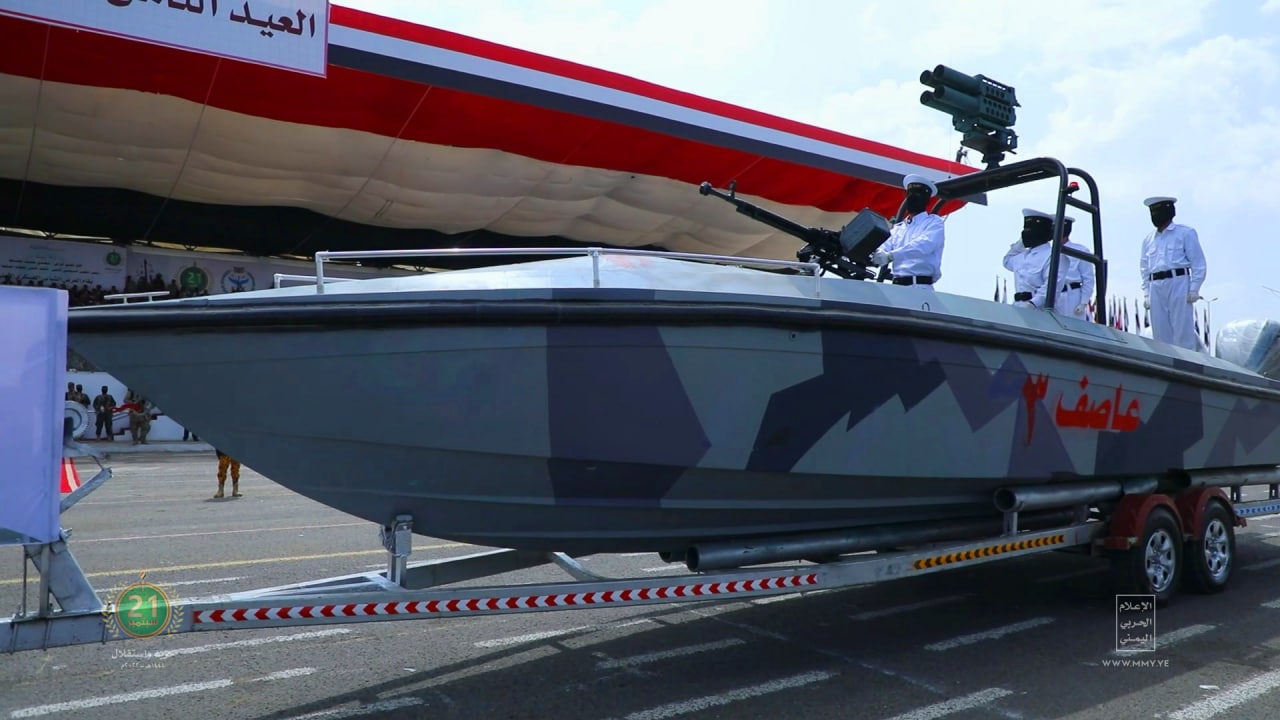
Combat boat ‘Asef3’ (The Houthi official website)
The Houthis claim that they own a wide set of naval mines including ‘Mujahid1’, ‘Mujahid2’, ‘Masjor1’, ‘Masjor2’, ‘Karar1’, ‘Karar2’, ‘Karar3’, ‘Asef2’, ‘Asef3’, ‘Asef4’, ‘Shawaz’, ‘Thaqeb’, ‘Owais’ and ‘Al-Naziaat’. ‘Masjor2’ is among the biggest Houthi mines as it weighs 1 ton, including 740 kilograms of explosives”, according to the Houthi website.
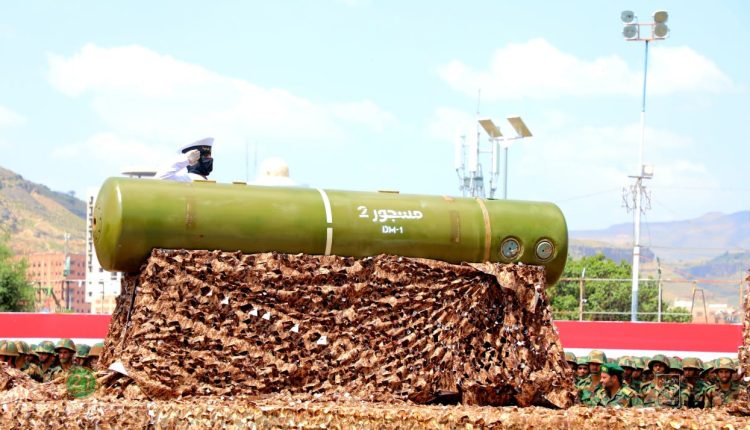
Naval mine ‘Masjor2’ (The Houthi official website)
As for the Houthi air defense capabilities, the Washington Institute For Near East Policy said: “When the rebels took Sana in September 2014 and other parts of the country in March 2015, they seized most of the government's inventory of ex-Soviet SAMs and associated radars, including SA-2s, SA-3s, SA-6s, SA-9s and man-portable air defense systems.”
However, “these weapons never posed a serious threat to coalition aircraft. First, many of them were obsolete and in need of repair. Second, the coalition destroyed many fixed air-defense sites, radars, and rebel-operated interceptor aircraft by mid-April 2015,” according to the institute.
It said the Houthis converted many of the surviving SA-2 missiles into short-range, surface-to-surface ballistic missiles called the Qaher-1 and 2. They also converted Russian-made heat-seeking air-to-air missiles (the AA-10 Alamo-B, the AA-11, and probably the AA-8 and AA-7) into truck-launched anti-aircraft weapons. This has somewhat changed the reality of their air defense capabilities to become stronger, according to the report.
Additionally, the Washington Institute said: “These improvised systems are used for "SAMbushes"—close-range sneak attacks against coalition aircraft. Such attacks are more difficult to counter because they do not rely on detectable radar homing; instead, they use heat-seeking infrared sensors to target jets overflying mountaintops”.
In another analysis, the Washington Institute indicated that “the Houthi one-way attack drones present a longer-range threat, albeit a less destructive one”.
It added: “The only known Houthi version capable of targeting a moving ship is the Shahab, derived from the Sammad family. Equipped with an electro-optical (apparently daylight only) terminal guidance seeker head, the drone is believed to have a maximum range between 600 and 1,200 km while carrying a relatively small warhead of about 40 kilograms”.
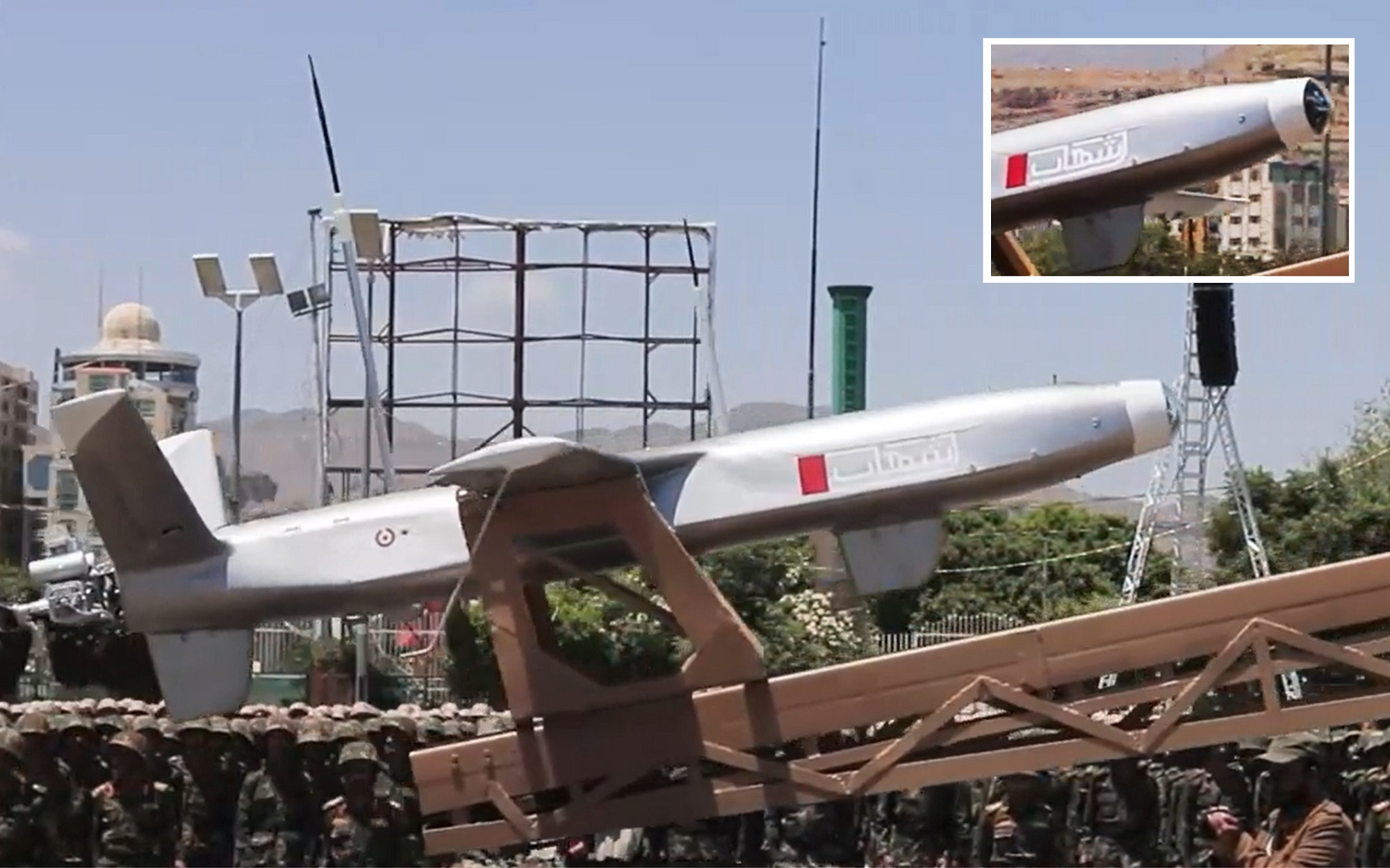
A ‘Shahab’ drone affiliated with the Houthis (Al-Masirah TV channel)
On November 8, 2023, the Houthi military spokesman Yahya Sarea announced that the group had shot down an MQ-9 US drone in the territorial waters of Yemen. The statement indicated that the operation “was carried out by using the proper weapon” without identifying it. It was likely an attempt to prove the development of the militia's air defense capabilities.
The Houthi’s effectiveness against the US
On January 10, the Houthis announced that they had attacked the US Navy in the Red Sea for the first time, using 18 drones as well as ballistic and cruise missiles. The attack was completely thwarted and didn't cause any material or human losses, according to the US Central Command. Earlier, on November 15, US Navy destroyer USS Thomas Hudner shot down a drone headed toward the ship that had been launched from Yemen. There was no confirmation that the destroyer was the drone’s direct target.
Over the past two months, the Houthis have practically succeeded in targeting commercial vessels, including two American ships, transiting the Gulf of Aden and the Red Sea. The attacks caused fires and damage in some of these vessels. The Houthis claim that they intentionally minimize the damage to prevent the sinking of the ships.
Despite the ongoing US strikes against the Houthis, there are different estimates about the scale of damage that hit the Houthi military capabilities.
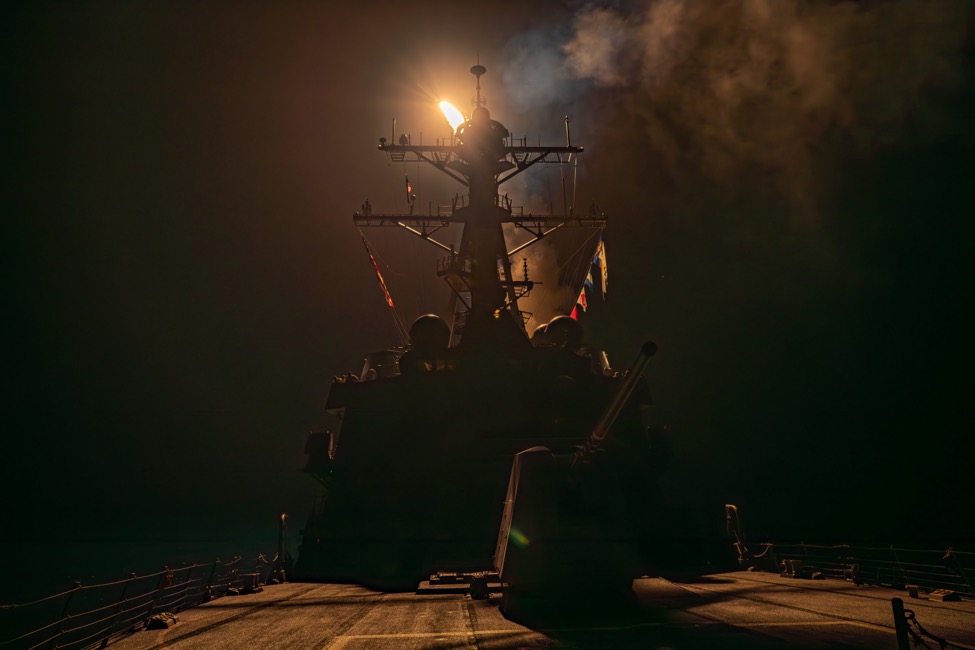
An American warship launches a Tomahawk missile to strike the Houthis (US Central Command)
On January 13, two US officials told ’The New York Times‘ that “the US-led airstrikes had damaged or destroyed only about 20 to 30 percent of the Houthis’ offensive capability”. On Sunday (January 21), a Pentagon official told ‘The Wall Street Journal’ that “about 25% of the Houthis’ military capabilities is estimated to be destroyed”.
On January 18, the Houthi leader Abdulmalik Al-Houthi downplayed the impact of the American strikes on the militia’s military capabilities. He said: “The American-British strikes won’t affect us.”
In a televised speech, broadcasted by ‘Al-Masirah’, he added: “The American-British aggression will contribute more and more to developing our military capabilities even further.” He claimed that the Houthis have actually begun developing their armaments and that the Americans know the type of weapon used by his group against their ship. He stressed that the militia has largely developed its own military capabilities over the past nine years.
The deterrence purpose
American expert Andrew Korybko, who specializes in the hybrid war, told ’South24 Center‘: “The Houthis are at least capable of disturbing vessels by using drones and small boat attacks. The worst scenario will be targeting ships with ballistic missiles.”
He added: “The first possibility has less risk of major escalation and it will allow the Houthis to pretend that they won’t retreat. The second one will lead to major escalation which will threaten their control on North Yemen as a whole. It isn’t clear whether they have adequate self-restraint to stick to the first scenario or not.”
Korybko pointed out that “the sinking of a ship affiliated with the coalition will likely lead to a comprehensive bombing campaign against the Houthis similar to Iraq in 2003, Libya in 2011 and Mosul and Raqqa. The possible aim behind that is to punish the Houthis in a crushing way to prevent the launching of similar attacks by other groups in the future.”
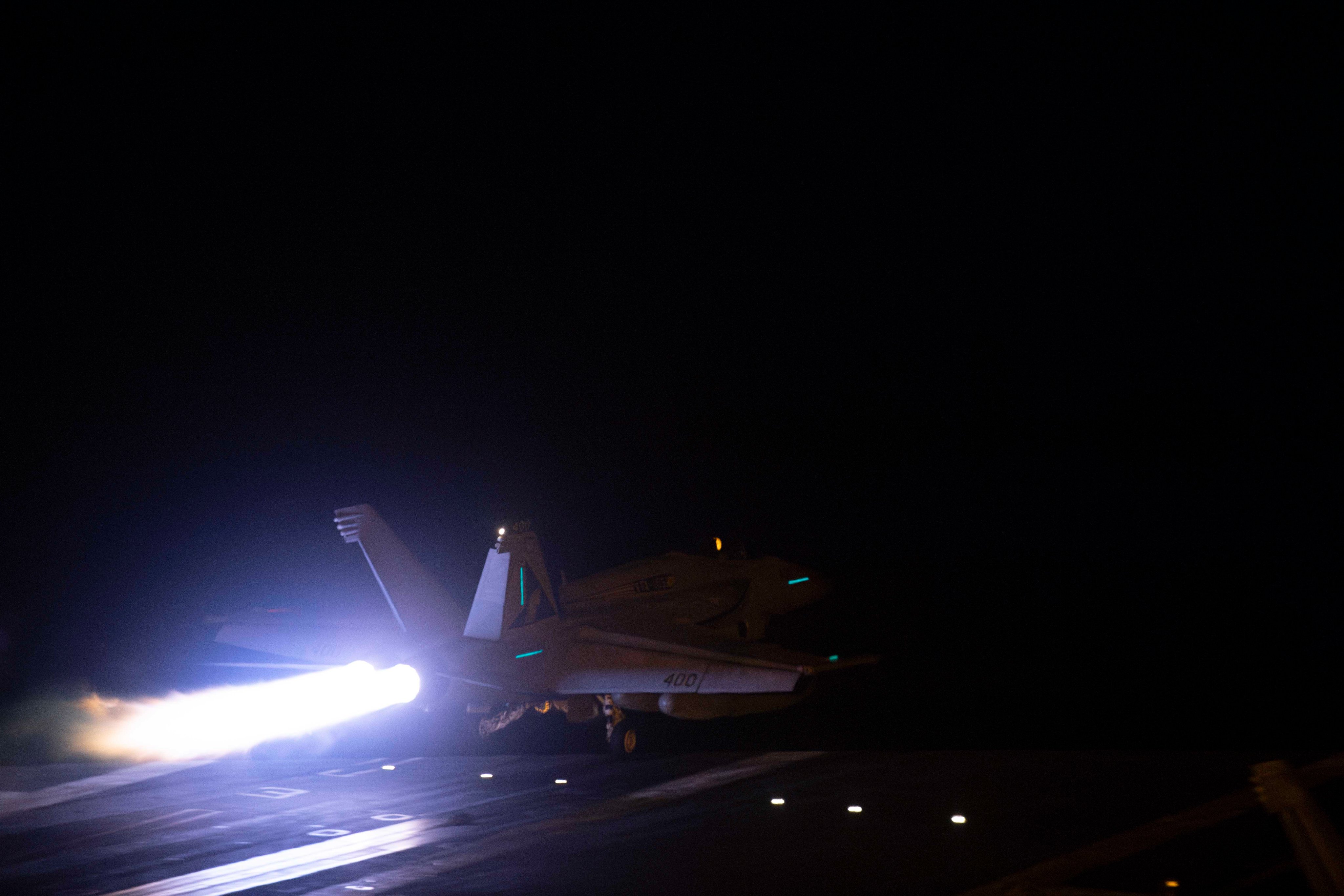
An American plane on its way to strike the Houthis (US Central Command)
With regard to the impact of the American-British strikes against the Houthis, Korybko said: “It seems that they wanted to send a deterrent message to the Houthis, without destroying their military capabilities completely, in order to maintain the power balance in Yemen. It seems that the US and UK aren’t currently interested in waging a larger war or re-igniting the ongoing war in Yemen.”
Yemeni military expert Waddah Al-Oubali told ’South24 Center‘ that “all the Houthi military capabilities seem ineffective in comparison to the supremacy of the American-British interception systems”.
He explained that from a military perspective, “there is no comparison between the American-British and the Houthi capabilities. The latter are limited to primitive weapons that can be used in tactical operations to cause harm, no more. Moreover, the Houthi capabilities are limited at both firing and technological levels if compared with the minimum American and British degree of capability”.
In an indication of the Houthi’s military weakness before the US, ‘Business Insider’ newspaper said: “The Houthi rebels in Yemen have one of the world's strangest fighter jet fleets — a single, aged F-5 fighter jet. It’s unlikely to be much good helping them against the US-led coalition.” Indeed, the Houthis previously displayed a jet plane in the skies of Sanaa, in addition to a helicopter that it used to seize the ‘Galaxy Leader’ cargo ship on November 19.
Al-Oubali believes that “if the Houthi threats escalate, the international community will find itself obliged to reformulate its security strategies and its evaluation of the situation in a way that would lead them to renew support to the Yemeni national forces in order to diminish the Houthi’s maneuvering capabilities through liberating Al-Hodeidah and the western coast”.
According to the International Institute for Strategic Studies, “the Houthis lack advanced intelligence, surveillance, and reconnaissance (ISR) tools, such as maritime patrol aircraft and satellites, which are usually associated with providing targeting information for long-range anti-ship systems”.
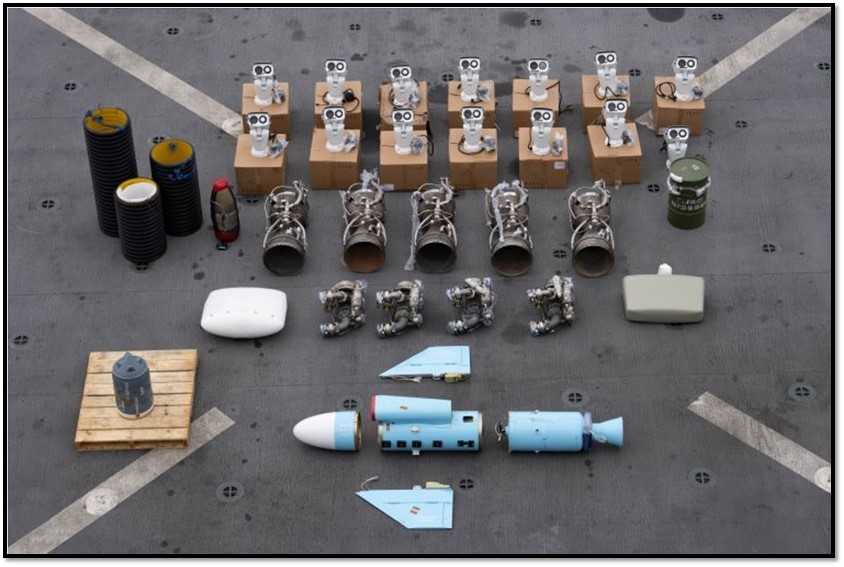
US Central Command
The US Department of State’s decision to re-designate the Houthis in the terrorist list will likely gradually reduce their ability to fund and launch more attacks due to their heavy reliance on Iran. On January 11, the US Navy thwarted - for the first time since the Houthi attacks against international shipping - an attempt to smuggle components of Iranian ballistic and cruise missiles that were allegedly headed to the Houthis.